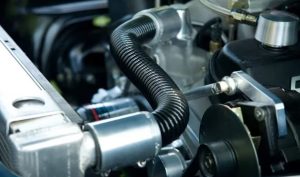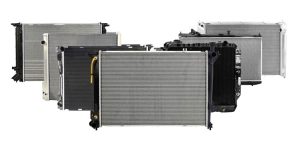Radiators are a crucial component in a vehicle’s cooling system, especially in high-performance or demanding environments. While the material of the radiator (e.g., aluminum or copper) is important, design aspects such as tube size, fin density, and core type can have an even greater impact on cooling efficiency.

Understanding how these elements influence heat dissipation is essential for anyone upgrading their vehicle’s cooling system — be it for racing, towing, or simply maintaining reliability in extreme climates.
This article explores the key radiator design features that directly affect performance and cooling efficiency.
Tube Size and Shape
The tubes in a radiator are where coolant flows, transferring heat to the surrounding fins. The size, number, and shape of these tubes can significantly impact cooling.
Tube Size
| Tube Type | Characteristics | Effect on Cooling |
|---|---|---|
| Narrow Tubes | Allow more tubes per row | Faster heat transfer, more surface area |
| Wide Tubes | Higher coolant volume per tube | Slower heat transfer, but lower flow resistance |
| Oval/Flat Tubes | Increased surface area compared to round | Better heat exchange and airflow |
Larger or wider tubes offer greater coolant capacity, which can be beneficial under heavy loads. However, narrower tubes arranged in greater quantity can increase the surface area for more efficient cooling.
Multi-Rows vs. Single-Row
-
Single-row radiators with large flat tubes (e.g., 1″ or more) are increasingly common in performance radiators.
-
Multi-row radiators (2-4 rows) are effective but can restrict airflow and add weight.
Fin Density and Design
The fins in a radiator are thin metal sheets that conduct heat from the tubes to the air. Their density (fins per inch, or FPI) and shape influence how efficiently heat is released into the surrounding environment.
Fin Density
| FPI (Fins Per Inch) | Performance Traits |
|---|---|
| Low (8-12 FPI) | Less airflow restriction, suitable for low-speed vehicles |
| Medium (14-18 FPI) | Balanced airflow and heat dissipation |
| High (20+ FPI) | Maximum heat transfer, requires strong airflow |
-
High FPI radiators require powerful fans or vehicles with high-speed airflow.
-
Low FPI radiators are better in dusty or off-road conditions where airflow may be limited.
Fin Types
-
Louvered Fins: Small slits in the fins create turbulence, improving heat dissipation.
-
Flat Fins: Simpler and cheaper, but less efficient in airflow disruption.
Optimized fin design can dramatically improve a radiator’s performance without increasing size or tube count.
Core Types
The core is the central portion of the radiator, made up of tubes and fins. There are several types of radiator cores, each with its own performance characteristics.
Core Configurations
| Core Type | Description | Cooling Efficiency |
|---|---|---|
| Single Core | One row of tubes with fins | Lightweight, adequate for stock applications |
| Dual Core | Two rows of tubes | Better cooling, slightly more airflow resistance |
| Triple/Quad Core | 3-4 rows of tubes, often thicker | High cooling, but heavier and airflow restrictive |
| Crossflow Core | Coolant flows side-to-side | More efficient in compact designs |
| Downflow Core | Coolant flows top-to-bottom | Traditional design, less efficient for tight spaces |
Crossflow designs are generally preferred in performance applications due to improved cooling and packaging flexibility.
Core Thickness and Surface Area
The thicker the radiator, the more coolant it can hold and the more surface area it has for cooling. But thicker cores can restrict airflow, especially if the vehicle’s fan and ducting aren’t optimized.
| Core Thickness | Cooling Potential | Airflow Impact |
|---|---|---|
| 1 inch (25 mm) | Adequate for stock or mild upgrades | Low restriction |
| 2 inches (50 mm) | Ideal for moderate performance | Moderate airflow reduction |
| 3 inches (75+ mm) | Excellent for racing/towing | Requires strong airflow system |
When increasing core thickness, ensure your fans, shroud, and front-end airflow are matched to prevent heat soak.
Radiator Design Optimization Tips
To get the best out of your cooling system, consider the following recommendations based on your vehicle’s usage:
For Performance Street Vehicles:
-
Use single or dual-core aluminum radiator
-
Medium fin density (14-18 FPI)
-
Crossflow core preferred
For Racing:
-
High fin density (20+ FPI)
-
Single-row with wide flat tubes or dual-row narrow tube design
-
Strong electric fan setup required
For Towing/Heavy-Duty Use:
-
Triple-core or thicker dual-core radiators
-
Lower fin density to avoid clogging with dust
-
Consider copper core for superior heat conduction
For Off-Road Vehicles:
-
Low FPI to avoid clogging with debris
-
Reinforced tanks and brackets for durability
-
Shrouded fan setup for low-speed cooling
Summary: Design Features vs. Cooling Efficiency
| Design Element | Impact on Efficiency |
|---|---|
| Tube Size | Affects coolant volume and heat transfer rate |
| Fin Density | Directly impacts air-to-coolant heat exchange |
| Core Type | Determines flow path and capacity |
| Core Thickness | Influences capacity and surface area |
Each of these factors contributes to overall radiator efficiency. A balanced design tailored to the vehicle’s specific application provides the best results.
Where to Buy Radiator & Components Online

Whether you’re upgrading your performance vehicle or replacing a factory unit, it’s crucial to select radiator components that match your design and performance needs. For a wide selection of quality radiators, tubes, fins, fans, and core components, visit:
Buy Radiator & Components online
Final Thoughts
Radiator design is far more than just choosing between copper and aluminum. Elements like tube width, fin density, and core configuration play critical roles in determining cooling performance. Whether you’re building a race car, towing a trailer, or preparing for off-road adventures, understanding these principles will help you choose the right radiator for optimal thermal control.
An efficient radiator means a cooler engine, better performance, and a longer engine lifespan. Choose wisely — and make sure to buy from trusted suppliers to ensure reliability and quality.